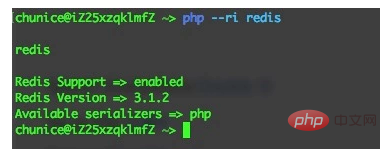What to do when Redis meets ThinkPHP5!
The following will be introduced to you by the thinkphp framework tutorial column. When Redis meets ThinkPHP5, I hope it will be helpful to friends in need!

HELLO,REDIS
Redis is a K/V storage non-relational database, and the data is stored in memory; with Memcache is very similar, but Redis supports more data structures (strings, linked lists, hashes, sets, etc.). The reading and writing speed is very fast. In the official test, the reading speed is 110,000 times/s and the writing speed is 81,000 times/s. Usually we use Redis for queues, caches and other places that have high performance requirements.
1. Installation Redis
[danger] The following only provides the installation process under Linux. It is recommended to use Centos 7 / Ubuntu 14 system
In addition to setting up a virtual machine or VPS to install Redis according to the article, it is also recommended that you directly use Sina Cloud to deploy the environment, which is more convenient and faster. The cloud beans provided by registering an account are free enough Use it to learn the entire book.
1.1 Compile and install
First we download the Redis installation package
$ > wget -c http://download.redis.io/releases/redis-3.2.8.tar.gz
After completing the download, unzip the installation package
$ > tar xzf redis-3.2.8.tar.gz
Enter the file Directory
$ > cd redis-3.2.8
Installation
$ > make
Copy the configuration file to the /etc/ directory
$ > cp redis.conf /etc/
Copy the command line tool to the /usr/local/bin/ directory, later If you use the redis command line tool again, you no longer need to go to the redis-3.2.8 directory
$ > cp redis-benchmark redis-cli redis-server /usr/local/bin/
Modify the configuration file and set redis to start as a daemon process
$ > vi /etc/redis.conf
Find the daemonize no modification Start Redis for deamonize yes
$ > redis-server /etc/redis.conf
Check whether the redis process starts normally
$ > ps -ef | grep redis
Check whether redis runs normally
$ > redis-cli $ [redis-cli]> set test test $ [redis-cli]> get test
The execution result returns test, that is, Redis is normal Run
1.2 docker installation
If your current system can use docker, it will be even simpler. You only need to execute one line of commands to complete the installation
$ > sudo docker run -d -p 6379:6379 --name redis-server tutum/redis
Redis installed using tutum/redis comes with a default password. Use the following command to view the redis connection password
$ > sudo docker logs redis-server

2. Install the Redis PECL extension
Can be compiled through the pecl command or through the source package Installation, this article uses the pecl command to install the Redis extension
Enter
$ > pecl install redis
on the command line. After installing the Redis PECL extension, execute the command to check whether Redis is installed successfully through the php --ri redis command. You can also check whether Redis is installed successfully through phpinfo or php -m.

#3. Install ThinkPHP5
You can use Composer to install ThinkPHP5 or directly download the ThinkPHP5 source code core package. This article uses Composer. To install
3.1 Install Composer
If you have already installed Composer, you can skip this step, but please make sure to use the composer self-update command to ensure that you have used the latest version Composer
Use the following command to download Composer.phar directly through the Composer official website and automatically install it in the /usr/local/bin/ directory
$ > php -r "readfile('https://getcomposer.org/installer');" | php -- --install-dir=/usr/local/bin/ --filename=composer $ > composer self-update
If the above installation process is extremely slow, you can try Use the following method to install through the Composer domestic image.
$ > php -r "readfile('http://install.phpcomposer.com/installer');" | php -- --install-dir=/usr/local/bin/ --filename=composer $ > composer config -g repo.packagist composer https://packagist.phpcomposer.com $ > composer self-update
3.2 Install ThinkPHP5 framework
Use the following command to install the latest version of ThinkPHP5 framework into the thinkRedisFirst folder in the current directory
$ > composer create-project topthink/think thinkRedisFirst --prefer-dist
4.Hello World
public function redis()
{
$redis = new \Redis();
$redis->connect('127.0.0.1', 6379);
// $redis->auth('password'); # 如果没有密码则不需要这行
//把 'test'字符串存入 redis
$redis->set('test_name', 'test');
// 把 'test_name' 的 值从 redis 读取出来
echo $redis->get('test_name');
}If the return result shows test, it means that both redis and phpredis are running normally.
The above is the detailed content of What to do when Redis meets ThinkPHP5!. For more information, please follow other related articles on the PHP Chinese website!

Hot AI Tools

Undresser.AI Undress
AI-powered app for creating realistic nude photos

AI Clothes Remover
Online AI tool for removing clothes from photos.

Undress AI Tool
Undress images for free

Clothoff.io
AI clothes remover

Video Face Swap
Swap faces in any video effortlessly with our completely free AI face swap tool!

Hot Article

Hot Tools

Notepad++7.3.1
Easy-to-use and free code editor

SublimeText3 Chinese version
Chinese version, very easy to use

Zend Studio 13.0.1
Powerful PHP integrated development environment

Dreamweaver CS6
Visual web development tools

SublimeText3 Mac version
God-level code editing software (SublimeText3)

Hot Topics
 1665
1665
 14
14
 1423
1423
 52
52
 1321
1321
 25
25
 1269
1269
 29
29
 1249
1249
 24
24
 How to build the redis cluster mode
Apr 10, 2025 pm 10:15 PM
How to build the redis cluster mode
Apr 10, 2025 pm 10:15 PM
Redis cluster mode deploys Redis instances to multiple servers through sharding, improving scalability and availability. The construction steps are as follows: Create odd Redis instances with different ports; Create 3 sentinel instances, monitor Redis instances and failover; configure sentinel configuration files, add monitoring Redis instance information and failover settings; configure Redis instance configuration files, enable cluster mode and specify the cluster information file path; create nodes.conf file, containing information of each Redis instance; start the cluster, execute the create command to create a cluster and specify the number of replicas; log in to the cluster to execute the CLUSTER INFO command to verify the cluster status; make
 How to clear redis data
Apr 10, 2025 pm 10:06 PM
How to clear redis data
Apr 10, 2025 pm 10:06 PM
How to clear Redis data: Use the FLUSHALL command to clear all key values. Use the FLUSHDB command to clear the key value of the currently selected database. Use SELECT to switch databases, and then use FLUSHDB to clear multiple databases. Use the DEL command to delete a specific key. Use the redis-cli tool to clear the data.
 How to read redis queue
Apr 10, 2025 pm 10:12 PM
How to read redis queue
Apr 10, 2025 pm 10:12 PM
To read a queue from Redis, you need to get the queue name, read the elements using the LPOP command, and process the empty queue. The specific steps are as follows: Get the queue name: name it with the prefix of "queue:" such as "queue:my-queue". Use the LPOP command: Eject the element from the head of the queue and return its value, such as LPOP queue:my-queue. Processing empty queues: If the queue is empty, LPOP returns nil, and you can check whether the queue exists before reading the element.
 How to configure Lua script execution time in centos redis
Apr 14, 2025 pm 02:12 PM
How to configure Lua script execution time in centos redis
Apr 14, 2025 pm 02:12 PM
On CentOS systems, you can limit the execution time of Lua scripts by modifying Redis configuration files or using Redis commands to prevent malicious scripts from consuming too much resources. Method 1: Modify the Redis configuration file and locate the Redis configuration file: The Redis configuration file is usually located in /etc/redis/redis.conf. Edit configuration file: Open the configuration file using a text editor (such as vi or nano): sudovi/etc/redis/redis.conf Set the Lua script execution time limit: Add or modify the following lines in the configuration file to set the maximum execution time of the Lua script (unit: milliseconds)
 How to use the redis command line
Apr 10, 2025 pm 10:18 PM
How to use the redis command line
Apr 10, 2025 pm 10:18 PM
Use the Redis command line tool (redis-cli) to manage and operate Redis through the following steps: Connect to the server, specify the address and port. Send commands to the server using the command name and parameters. Use the HELP command to view help information for a specific command. Use the QUIT command to exit the command line tool.
 How to implement redis counter
Apr 10, 2025 pm 10:21 PM
How to implement redis counter
Apr 10, 2025 pm 10:21 PM
Redis counter is a mechanism that uses Redis key-value pair storage to implement counting operations, including the following steps: creating counter keys, increasing counts, decreasing counts, resetting counts, and obtaining counts. The advantages of Redis counters include fast speed, high concurrency, durability and simplicity and ease of use. It can be used in scenarios such as user access counting, real-time metric tracking, game scores and rankings, and order processing counting.
 How to set the redis expiration policy
Apr 10, 2025 pm 10:03 PM
How to set the redis expiration policy
Apr 10, 2025 pm 10:03 PM
There are two types of Redis data expiration strategies: periodic deletion: periodic scan to delete the expired key, which can be set through expired-time-cap-remove-count and expired-time-cap-remove-delay parameters. Lazy Deletion: Check for deletion expired keys only when keys are read or written. They can be set through lazyfree-lazy-eviction, lazyfree-lazy-expire, lazyfree-lazy-user-del parameters.
 How to optimize the performance of debian readdir
Apr 13, 2025 am 08:48 AM
How to optimize the performance of debian readdir
Apr 13, 2025 am 08:48 AM
In Debian systems, readdir system calls are used to read directory contents. If its performance is not good, try the following optimization strategy: Simplify the number of directory files: Split large directories into multiple small directories as much as possible, reducing the number of items processed per readdir call. Enable directory content caching: build a cache mechanism, update the cache regularly or when directory content changes, and reduce frequent calls to readdir. Memory caches (such as Memcached or Redis) or local caches (such as files or databases) can be considered. Adopt efficient data structure: If you implement directory traversal by yourself, select more efficient data structures (such as hash tables instead of linear search) to store and access directory information




